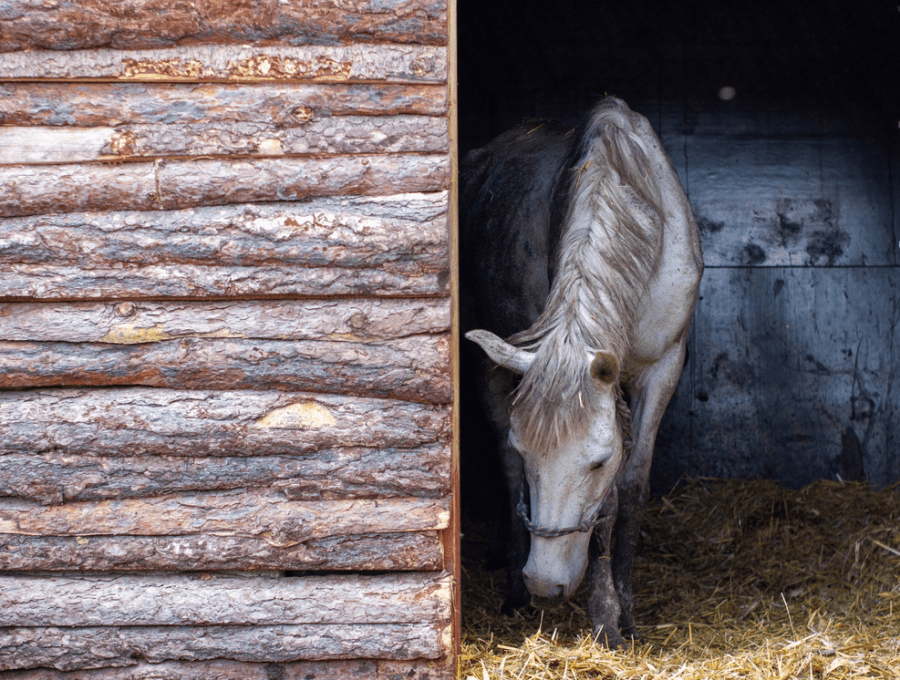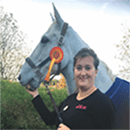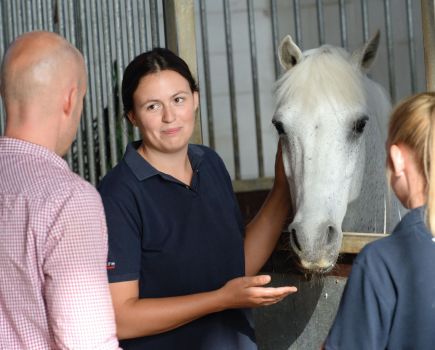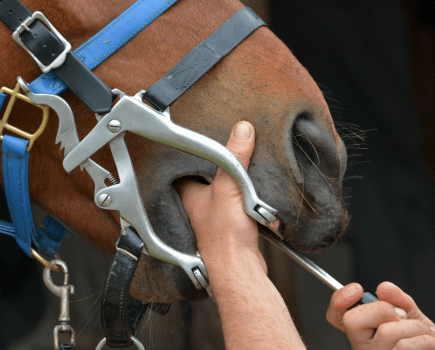Mother Nature designed horses to eat from the floor, yet haynets, racks, and over-the-door buckets designed for feeding off the ground are a familiar sight on many a yard.
Horses in the wild will spend 16-18 hours grazing every day, mostly with their heads down to eat grass. A small percentage of their time will be spent with their heads up to forage trees and shrubs — and enabling your horse to do this at their leisure is a great way to enrich their diet.
Why the ground is best
There are a number of physiological reasons why eating with their head down is best for our horses.
Teeth alignment
“We know that horse teeth are better aligned when the head is down and the jaw is able to move more accurately,” says independent nutritionist Donna Case of The Horse Feed Guru.
Freedom of the jaw
“The mandible (jaw bone), when down in a grazing position, can move up and down, from side to side, and forward and back without restriction,” adds Donna.
Feeding from a high position causes the lower jaw to slide back, altering the alignment of the teeth and chewing patterns and it increases the risk of ramps and hooks developing.
Longer chewing
“The horse is also likely to chew for longer with their head down and be more thorough about the way they chew,” says Donna.
“The more they chew, the more saliva they produce before they swallow.
“Saliva acts as an acid buffer in the stomach and helps to reduce the risk of gastric ulcers, meaning an overall healthier digestive system.”
Cleaner airways
A lower eating position also encourages airway drainage and that helps to reduce the inhalation of feed particles and dust.
They move more
“When horses are out at grass, it’s not just the fact that they’re eating little and often, it’s also that they move a step forwards with every few mouthfuls,” explains Donna.
“A horse in the wild will move several kilometres in a day while grazing. Movement plays a big part in terms of gas and dropping removal.
“Movement helps to keep the food and gas travelling along the digestive system and so horses who are suddenly put on box rest could be at risk of colic.”
Muscular comfort
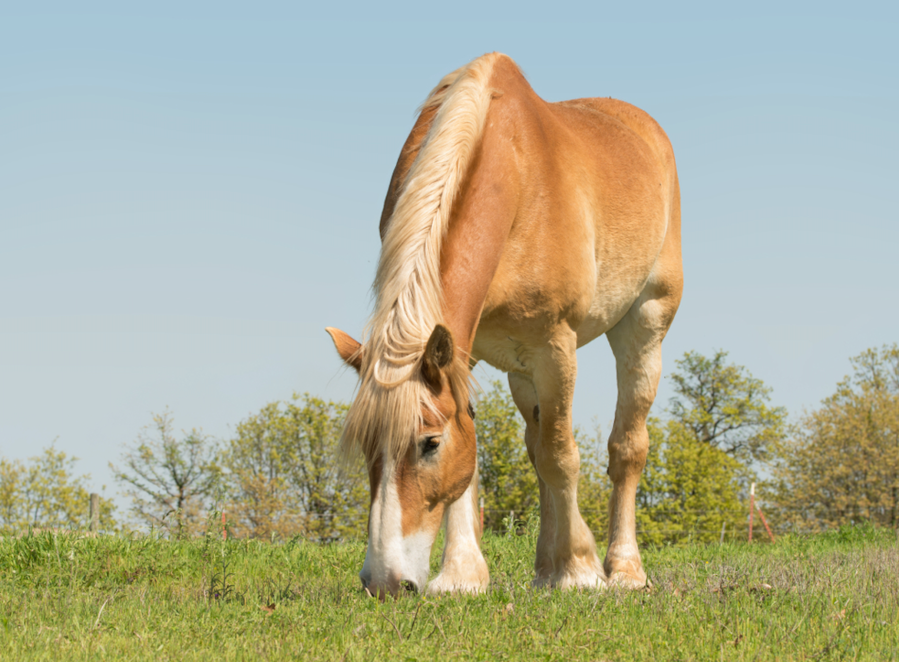
Watching how your horse grazes in the field can reveal a lot about their musculoskeletal comfort and asymmetry.
“Horses who are comfortable and symmetrical graze and move around without needing to lift up their heads. They graze with both the left and right front legs forward evenly,” says biomechanics expert Gillian Higgins who runs Horses Inside Out.
“Asymmetrical horses, and those with possible discomfort, will graze in a comfortable position for a while and will then raise their head before moving to the next spot.
“Uncomfortable horses will also widen their forelimbs in order to graze, spending more time with a preferred foreleg forward than the other,” she adds.
“This discomfort and asymmetry are usually also seen in their biomechanics and how they move. It can cause them to become mechanically lame, as do issues with uneven hooves.”
Posture
The neck and back ligaments play a major part in supporting the horse’s posture, and different feeding postures can have an impact on them — some good and some bad.
“The nuchal ligament acts as an energy-saving device that reduces the amount of muscular effort required to support, raise and lower the head, hold it in position and maintain the correct alignment of the cervical vertebrae,” Gillian explains.
“The nuchal ligament suspends a horse’s head when he’s sleeping standing up. It’s more elastic than other ligaments which allows it to stretch when the horse is ridden in an outline.”
The nuchal ligament controls and stabilises movement of the spine at the highest point of the withers.
“This acts as a pivot, which alongside the supraspinous ligament, helps to keep the back in the correct position,” continues Gillian.
“The nuchal and the supraspinous ligaments are vital for maintaining spinal posture.”
The nuchal ligament
Head down
When the horse’s head is down, the nuchal ligament is pulled tight.
This, in turn, pulls on the supraspinous ligament, which prises the thoracic vertebrae at the withers slightly apart, causing the back to rise and the ribcage to lift.
Head up
When the head is raised, the neck becomes hollow and the nuchal ligament loosens, which causes the horse’s back to hollow.
Continually going in this hollow outline results in horses being more prone to developing issues with their back.
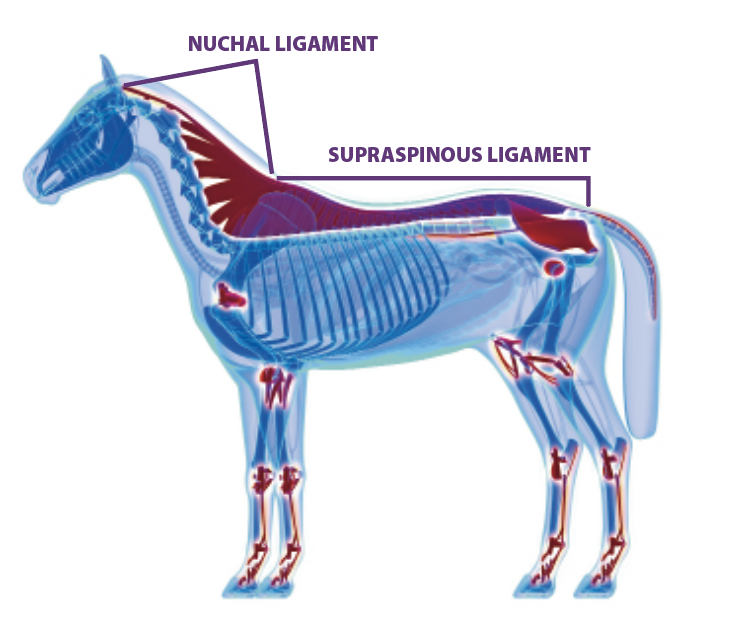
Pros
Gillian says the pros of feeding a horse off the floor are:
- It encourages better alignment of the spine.
- The nuchal and supraspinous ligaments support the weight of the back and abdomen with little muscular effort, which reduces muscle tension.
- Supports the correct alignment through the cervical vertebrae.
- Keeps the pharynx, trachea and oesophagus open and straight, which improves function.
- Helps to develop the correct muscles and structures involved in supporting the back and carrying the weight of the rider.
- In a head low position, mucus removes dust from the air passages through the nose.
- Encourages better digestion and production of saliva.
- Enables efficient chewing which also has big benefits the horse’s digestive system.
- Teeth are better aligned so that wear is more even.
- With the head in a low position, the parasympathetic nervous system is stimulated which, in turn, encourages a state of relaxation.
- The horse can become caught in haynets that are tied too low.
Cons
However it’s not all good news. Gillian also points out the following downsides to giving a horse food on the floor:
- Difficult to control how quickly a horse eats, which is an important factor for those on a controlled diet.
- Horses who are messy in the stable and/or box walk can mix their hay into their bed, which is both a waste and can work out costly for the owner.
Advantages of haynets

Although feeding horses hay from haynets and racks placed high up can have some negative impacts on a horse’s musculoskeletal system and back, there are some occasions when feeding from chest height rather than the floor can actually be beneficial.
“When feeding from hedges, trees and shrubs that are quite tall, horses will eat with their head and neck high up, which is quite natural,” explains Gillian.
“When eating from chest height and upwards, horses also tend to stand square in front because they don’t need to spread their front feet to reach the ground.
“This can be beneficial for a horse with marked front feet asymmetry, as well as a horse with a consistently asymmetrical grazing stance.”
When a horse’s head is held in a higher position, they can also more evenly distribute the weight between his front and back feet, instead of the weight being pulled forward onto the forehand.
Another advantage of haynets is that dust and small particles fall from the hay, meaning that they are less likely to be ingested or inhaled. It is also easier to keep the stable tidy as you can easily sweep underneath the net.
When haynets are bad
Of course, there are also downsides to feeding from haynets and racks.
It encourages the horse to stand in a poor posture, with their head high and back hollowed while eating for long periods.
This causes the spaces between the spinous processes to become smaller, which can put pressure on the ligaments in the spine and on the muscular skeletal system.
Another downside is that a high head position stimulates the sympathetic nervous system that is associated with anxiety, tension and the flight response.
Also, as the horse pulls the hay from the net, the jerking movement can cause his back muscles to contract.
If this is repeated for hours every day, it will develop the back muscles that create back extension, which isn’t ideal for ridden horses.
Relocate haynets
Haynets that are tied particularly high are also more likely to encourage the horse to pull the hay out to one side with a twisting motion of his head.
“We know that horses, like us, prefer one side to another, so if their haynet is always tied in the same place, such as to one side of the stable door, there’s a chance that the horse will always pull the hay out to the same side, towards the door,” says Gillian.
“This can create asymmetry, so it’s worth thinking about the location of your haynet in the stable.”
Images © Shutterstock; diagram © Your Horse Library/Kelsey Media Ltd

